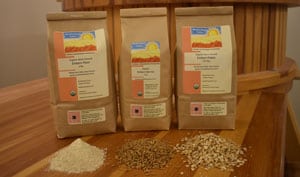Milky Way Einkorn Facts 2021
In 2021, Milky Way Einkorn was grown in Independence Township on one field of 1.1 acres on the farm established by Robert Leggett in 1815. Leggett had holdings totally 585 acres in the area and raised 1000 sheep. In addition to being a farmer, he was a breeder and dealer of 1st class Spanish sheep (Merino). Today the farm still raises sheep. Weatherbury Farm transitioned this land from conventional in 2013 and it was certified organic in 2015.
The einkorn was planted on October 14,2020.
Clover was frost seeded into the grain on March 7, 2021. (The clover suppresses weeds, aids in holding up the grain and, eventually provides nitrogen to the next crop.)
The einkorn was harvested on July 16, 2021.
For an illustrated explanation of how Weatherbury grains become flour, visit the from seed to flour page.
More Information on Milky Way Einkorn below the pictures.
Planting Einkorn
Two weeks after planting, the Milky Way Einkorn has emerged.
The event was captured by photographer Caroline Tompkins for an article on vogue.com
Milky Way Einkorn continues to grow over the winter. Now it has more tillers than when photographed last year.
Milky Way Einkorn is a winter planted grain — this means that the einkown needs to vernalize to produce grain. If you were to plant it in the spring, it would just look like grass and not develop any grain.
6 weeks later, the einkorn has grown taller and broader.
The field of einkorn looks like a gorgeous green lawn.
To the front, you can see the buffer required by organic standards.
On the top right. there is a small portion of a clover hay field. The clover is the result of clover that was frost seeded in 2020 on the grain crop in that field.
Happy Independence Day from Weatherbury’s soon to be Einkorn Flour!
As you can see the grain heads have now formed.
Harvesting our first crop on Einkorn!
Rain storms with high winds played some havoc with our einkorn — much of it has lodged (farm speak for fallen over). But with the use of crop lifters, the farmers were able to harvest most of it.
Unloading the Milky Way Einkorn into a gravity wagon. A tractor will pull the wagon back to the farm. Aerators are then placed in the wagon to bring down the moisture of the grain. The grain is stored in the wagon until it is cleaned.
With visions of einkorn flatbread dancing in our heads!
About Milky Way Einkorn
Einkorn is one of the three ancient hulled wheats. And even today at taste testings, einkorn flat bread always rates best. At Weatherbury Farm, we grow Milky Way Einkorn, an accession from the USDA small grains collection. It was collected in 1970 in Vorarlberg, Austria, grown out by 40 growers and bulked as the trials looked promising due to yield.
Einkorn, like spelt, is protected from the elements by a hull which doesn’t come free in harvest (unlike the hulls on wheat which do). The removal of the hull prior to milling requires special machinery. Weatherbury is lucky to have a dehuller, built by Farmer Nigel.
Products Milled from Milky Way Einkorn
Milky Way Einkorn is milled into whole unbleached einkorn flour. Einkorn flour can be used in place of whole wheat flour in most dishes from pie crusts to cakes to pancakes to bread.
Einkorn Flakes / Rolled Einkorn offers a new way to start your day.
Einkorn berries (also known as Farro Piccol0), can be used in everything from baked goods to soups and salads or use like rice in a berry bowl.
Health benefits of Einkorn
Einkorn is the most primitive form of wheat on Earth; it has never been hybridized. Thus, einkorn contains only 14 chromosomes; modern wheat contains 42. Einkorn doesn’t have the D chromosome, which may be connected with wheat intolerance. As a result, it is easier to digest and contains more protein and higher levels of fat, phosphorus, pyridoxine, potassium and beta-carotene than modern wheat.
More Information
Einkorn flour can be ordered either for our monthly on-farm pickup or you can have your order sent to you.
To read more about einkorn flour, please visit our products page.
More information on einkorn and other grains are on the grains we grow page.











